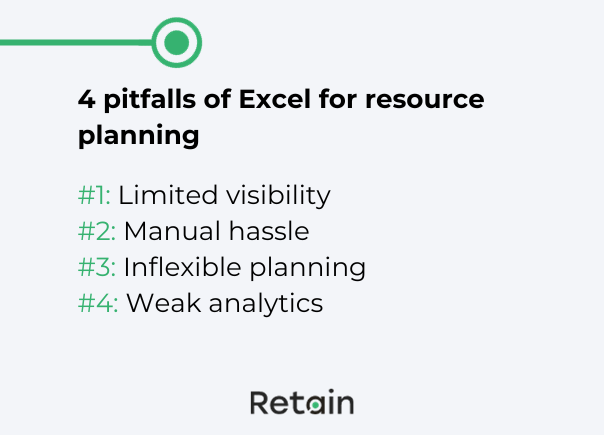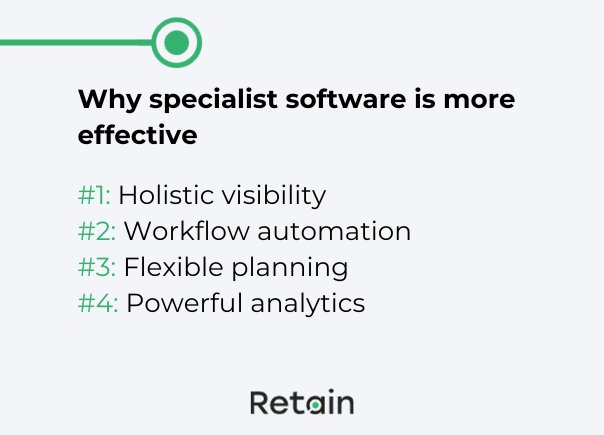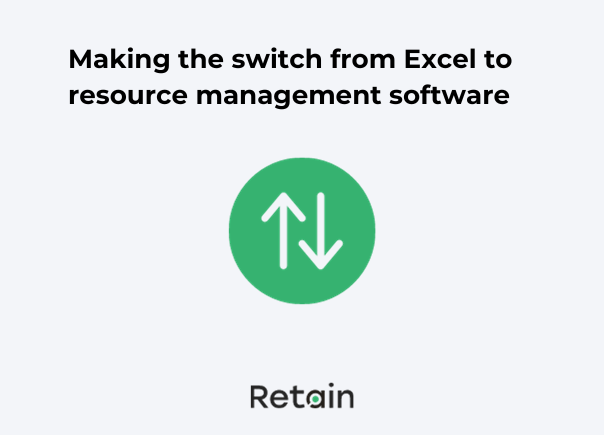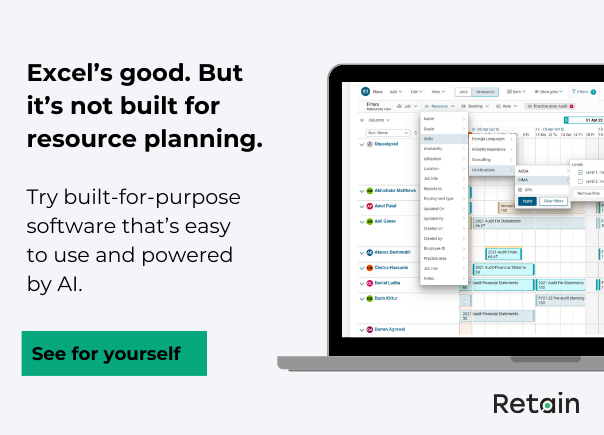(Updated on 07/11/23)
We all know staff are the biggest asset for businesses like management consultancies and accounting firms. Your people are your product. But maximising their utilisation while ensuring availability for incoming client work is easier said than done.
Excel is often the go-to workforce planning tool for some professional services firms, but is it really the most effective option?
Enter resource management software by Retain International – purpose-built to give you the insights needed to optimise resource allocation and project scheduling. But is it worth leaving the familiar comfort of spreadsheets behind?
In this post, we'll look at the limitations of Excel for resource planning, and why software is becoming essential. While change is hard, the payoff of modernising your approach can be game-changing.
The pitfalls of Excel for resource management

Excel is often the default planning tool for many organisations due to its accessibility and familiarity. But spreadsheets were designed for basic tables and calculations - not the complexities of resource management.
Relying on Excel can quickly become a bottleneck as your firm grows.
Let’s take a look at why:
?Limited visibility
Excel offers no bird's eye view of resource utilisation across projects. Tracking allocation, capacity, and demand in siloed spreadsheets gives an incomplete picture. This makes it hard to optimise assignments and staffing. What may seem like smooth sailing in individual plans can mask impending conflicts.
?Manual hassle
Spreadsheets need constant manual adjustments - a tedious process prone to errors. A minor tweak in one place can have cascading impacts. Maintaining consistent up-to-date data across multiple files with many users is virtually impossible. And unconnected plans degrade quickly.
❌Inflexible planning
Excel lacks the flexibility to easily accommodate volatile projects and priorities. Modelling scenarios like reallocating resources or comparing alternatives is clunky at best. Responding to shifts means reworking multiple plans. An absence of workflow rules also increases ambiguity for users.
?Weak analytics
While Excel can generate reports, number crunching is labour-intensive. Features like pivot tables help but don't eliminate the need for manual analysis. Lacking automation, it's hard to get real insights from your data. This prevents fact-based forecasting and optimisation.
In summary, spreadsheets clearly fall short for the needs of professional services firms juggling many people, projects, and priorities.
So is it time to consider software specifically designed for resource management? We'll dive into the benefits of doing so next.
Why specialised resource management software is more effective

Resource management software, like Retain, is specifically designed to handle the unique challenges of people-powered services businesses. It provides a centralised system to maximise resource utilisation while balancing supply and demand.
Let's look at some of the key capabilities:
?Holistic visibility
All resource data is maintained in a single platform, giving real-time visibility into utilisation and availability. Drag-and-drop scheduling, allocation tracking, and colour-coding make analysis intuitive. This helps optimise assignments and staffing for the big picture.
⚙️Workflow automation
The manual work of updating spreadsheets is eliminated through automation. Resource management software centralises information and keeps it consistent systemwide. Plus, changes and notifications happen in real-time across integrated plans.
?Flexible planning
Sophisticated tools support agile planning as projects evolve. Plus, scenario modelling enables "what-if" analysis to evaluate alternatives. Resources can be quickly reallocated as needs change. And workflow rules boost efficiency and consistency.
?Powerful analytics
Embedded reporting and analytics provide data-driven insights. Dashboards track key metrics like utilisation rate, capacity vs demand, and project progress. And forecasting and modeling capabilities assist long-term planning.
To sum up, by removing the constraints of spreadsheets, resource management software streamlines coordination between projects, managers, and staff. Financial planning and decision making also becomes more far more precise.
Next up, let's look at key considerations for making the switch.
Making the switch from Excel to Resource Management Software

Moving from relied-upon spreadsheets to new tech can feel like a big change. So here are key factors to think about when considering adopting dedicated resource management software:
1. Get stakeholder buy-in
A successful implementation might require company-wide enrollment. Make sure managers, project leads, and staff understand the benefits and provide input. Share the benefits and success stories to get people on board.
2. Prioritise ease of use
Choosing the right software is key. So make sure your chosen system facilitates existing processes, instead of complicating them. Look for solutions like Retain with intuitive and flexible UIs that are not overly complex. And make sure they provide sufficient training resources and support.
3. Assess integrations
Determine what other systems like HR, billing, and ERP the software should sync with for maximum benefit. The API integration potential is key for connecting plans across departments and functions.
4. Consider the cloud
Cloud-based solutions, like Retain, eliminate IT infrastructure burdens and offer advantages like mobile access and faster updates. But make sure you evaluate security protocols and offline accessibility needs for your situation.
5. Start small, then scale
As a final tip, phasing in implementation lets users get acclimated and processes get refined before full rollout. Begin with one team or department, then expand utilisation. Take time to gather feedback from team members as you go.
The bottom line: The move from Excel is no small feat, but the long-term payoff can transform how your firm manages its most precious resources. By taking the right approach, your organisation can hit the ground running with a future-proof solution.
Case example: Boosting profitability by switching from Excel to Resource Management Software
Pitcher Partners is a medium-sized accounting firm and is part of Baker Tilly International. With growth outpacing resource planning capabilities, the firm sought a better way to maximise staff utilisation. By implementing Retain resource management software, Pitcher Partners gained organisation-wide visibility into resource availability and project demands for more strategic planning.
The challenge
Rapid growth created greater complexity in resource planning and job costing and spreadsheet-based processes limited visibility into resources and workloads. Plus, resource conflicts and bottlenecks decreased utilisation and profitability.
The solution
They selected Retain for its user-friendly resource planning and demand management software, which also integrated with existing systems for firm-wide transparency into staff availability and project resourcing needs.
The Results
By moving beyond spreadsheets to advanced resource management, Pitcher Partner gained the visibility and flexibility needed to optimise staff utilisation. They saw business value instantly as they were able to plan (at a detailed staffing level) the year ahead. By booking in all their client projects for the next 12 months, provided their staff with clear visibility of their schedules and allowed them to strengthen their resource and engagement planning. The result was greater productivity, efficiency, and profitability firm-wide.
Leave spreadsheets in the past
Excel has become such a fixture that it's easy to overlook its limitations - especially for crucial tasks like resource planning. But as professional services firms strive for greater agility and efficiency, spreadsheet-based processes just can't keep up.
Constraints around data visibility, flexibility, collaboration, and analytics in Excel make resource management a constant struggle. But purpose-built software, like Retain offers a modern solution optimised for the needs of people-powered businesses.
No technology transition comes without growing pains. But the long-term benefits of centralised data, automated workflows, scenario modeling, and data-driven insights are too powerful to ignore.
Ready to take your firm to the next level? A small step outside the Excel comfort zone can position your people, projects, and profits for future success. Consult with our industry experts to explore how resource management technology can transform the way your business is run.
Or if you're not quite ready, you might also like our free Excel resource planning template, which you can access here.
Looking for more? Check out our complete guide to resource planning.
This comprehensive guide covers:
- Symptoms of poor resource planning (and how to cure them!)
- The formula for resource planning success
- Steps to future-proof your approach
- How a legacy system costs you money



